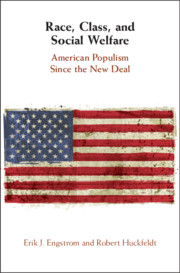Book contents
- Race, Class, and Social Welfare
- Race, Class, and Social Welfare
- Copyright page
- Dedication
- Contents
- Figures
- Tables
- Preface and Acknowledgments
- 1 American Politics and Social Welfare
- 2 Politics at the Intersection of Race, Class, and Oligarchy
- 3 Civil Rights, Social Welfare, and Populism
- 4 Civil Rights and Populism
- 5 Race, Class, and the End of the New Deal in the US Senate
- 6 Transforming the Twentieth-Century House
- 7 Race, Class, and a Transformed Political Economy
- 8 Dueling Populists and the Political Ecology of 2016
- 9 Conclusion: The Dangers of Upside-Down Populism
- Bibliography
- Index
8 - Dueling Populists and the Political Ecology of 2016
Published online by Cambridge University Press: 07 July 2020
- Race, Class, and Social Welfare
- Race, Class, and Social Welfare
- Copyright page
- Dedication
- Contents
- Figures
- Tables
- Preface and Acknowledgments
- 1 American Politics and Social Welfare
- 2 Politics at the Intersection of Race, Class, and Oligarchy
- 3 Civil Rights, Social Welfare, and Populism
- 4 Civil Rights and Populism
- 5 Race, Class, and the End of the New Deal in the US Senate
- 6 Transforming the Twentieth-Century House
- 7 Race, Class, and a Transformed Political Economy
- 8 Dueling Populists and the Political Ecology of 2016
- 9 Conclusion: The Dangers of Upside-Down Populism
- Bibliography
- Index
Summary
The 2016 presidential election demonstrated a dramatic resurgence of populism in American politics, in which the three most successful candidates – Trump, Clinton, and Sanders – advanced their own distinctive populist brands. Trump’s promise to “make America great again” involved a direct appeal to a socially and economically struggling white working class. Clinton’s campaign focused attention on the concerns of women, minorities, and the disadvantaged, at the same time that she cultivated support on Wall Street. As a democratic socialist, Sanders challenged Clinton’s campaign for the Democratic nomination from the left, advocating extended social welfare benefits and free higher education. These three candidates and their campaigns reflected the variegated history of populist appeals in American politics. Trump’s campaign reflected a regressive, divisive brand of populism with a long history in American politics that has been particularly vibrant in the American South. Sanders represented the democratic socialist tradition that has historically experienced the most difficulty in gaining a resilient base of support in American politics.
- Type
- Chapter
- Information
- Race, Class, and Social WelfareAmerican Populism Since the New Deal, pp. 157 - 181Publisher: Cambridge University PressPrint publication year: 2020



